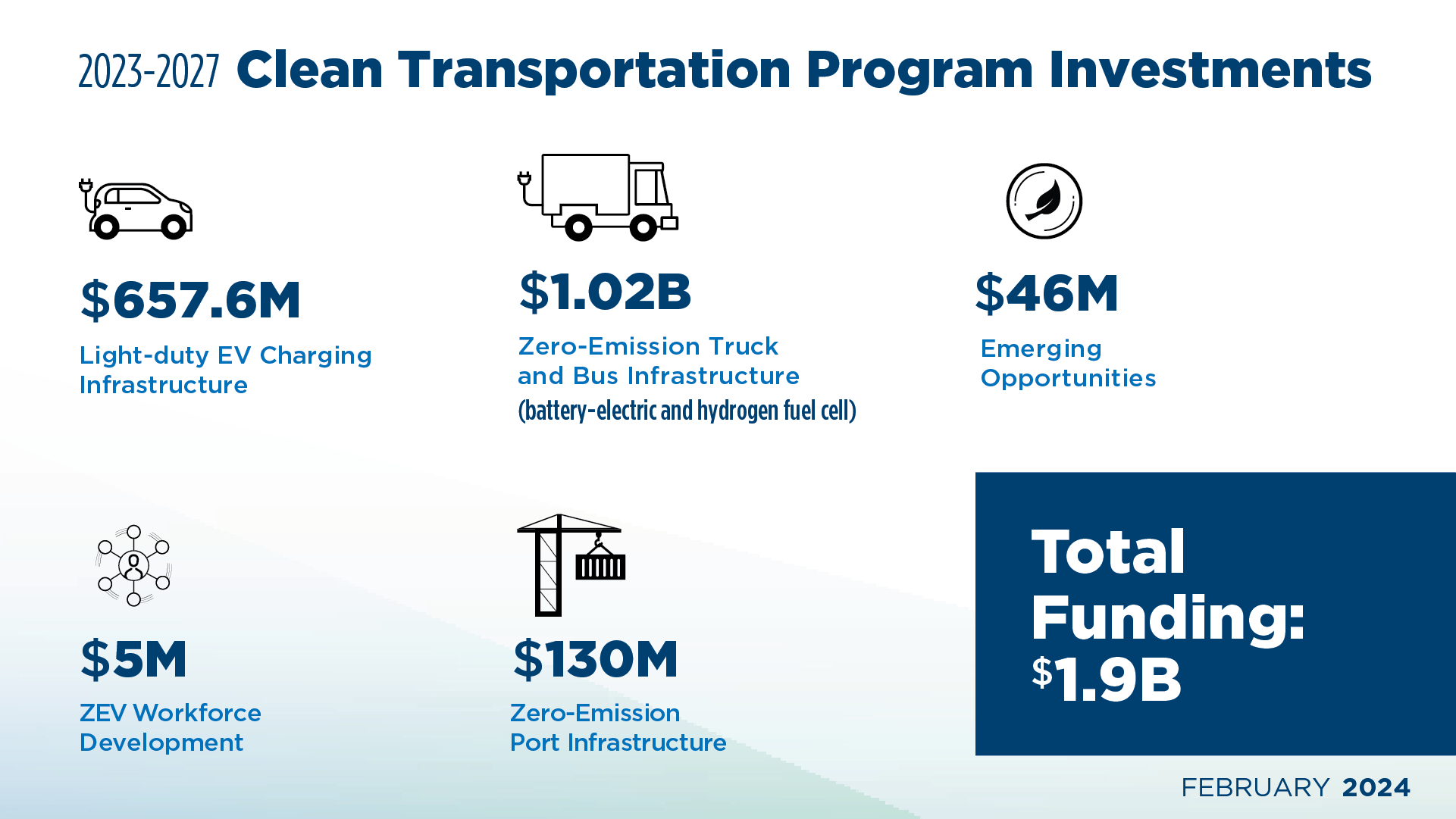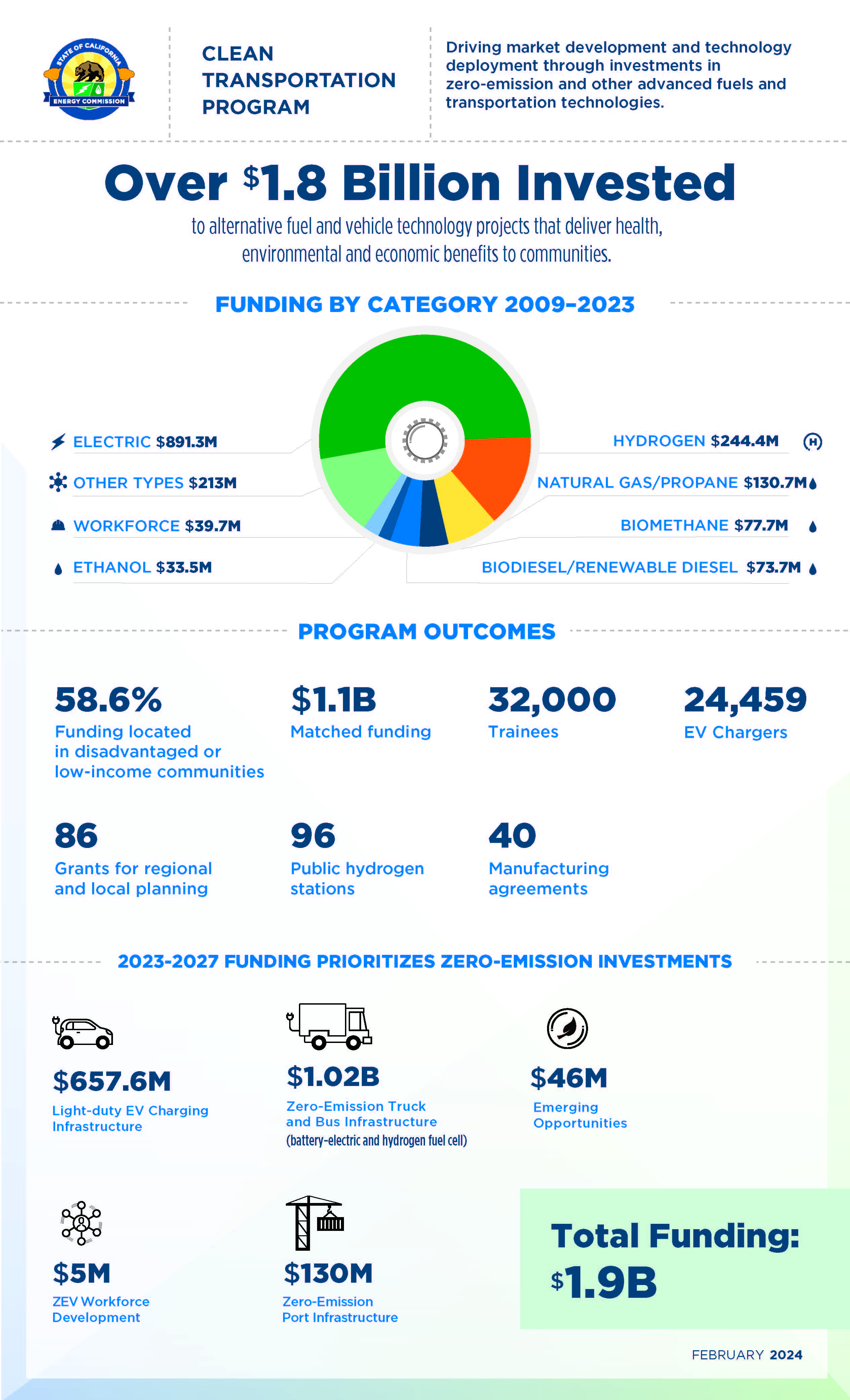For Immediate Release: February 14, 2024
WHAT TO KNOW: California is investing an unprecedented amount of funding to build a bigger, better network of charging and refueling infrastructure for zero-emission cars, trucks and buses.
SACRAMENTO – The California Energy Commission (CEC) today approved a $1.9 billion investment plan that accelerates progress on the state’s electric vehicle (EV) charging and hydrogen refueling goals. These investments will help deploy infrastructure for light, medium, and heavy-duty zero-emission vehicles (ZEV) across California, creating the most extensive charging and hydrogen refueling network in the country.
The plan details how the CEC’s Clean Transportation Program will spend $1.9 billion in state funding over the next four years, with at least 50 percent targeted to benefit priority populations. The funding is part of the $48 billion dollar California Climate Commitment, which includes more than $10 billion for ZEVs and ZEV infrastructure. The state has also received billions from the Biden-Harris Administration for clean transportation.
The funds approved today will result in 40,000 new chargers statewide. Nearly 94,000 public and shared private chargers are installed today. Combined with previous investment plans, funding from the federal government, utilities and other programs, the state expects to reach 250,000 chargers in the next few years. This is in addition to private installations and home chargers.
“We need to make sure that this is zero emission refueling infrastructure for everybody,” said CEC’s Lead Commissioner for Transportation Patty Monahan. “By investing a bulk of funds to benefit low-income and disadvantaged communities, the state is making sure communities most in need have better access to chargers and less pollution from trucks and buses.”

The funds will become available over the next four years and distributed to projects through competitive grants. Projects include direct incentive and rebate programs for businesses, non-profit organizations, tribes and public agencies.
Watch the YouTube shorts video.
Clean Transportation Program Highlights
First created in 2007, the Clean Transportation Program is one of the first transportation-focused funding efforts established to help advance the state’s climate change policies. To date, $1.8 billion has been invested in projects supporting ZEV infrastructure, alternative fuels and advanced vehicle technologies.
- Community Benefits: Awarded 59 percent of funding in disadvantaged or low-income communities.
- Chargers Installed: Installed or planned nearly 24,500 EV chargers.
- Hydrogen Stations Opened: Allocated funding for 96 public hydrogen fueling stations, 61 are open today.
- Car Charging Incentives: Created the California Electric Vehicle Infrastructure Project to provide streamlined incentives for EV chargers.
- Truck and Bus Incentives: Awarded $100 million to 120 projects for truck and bus charging and refueling through the Energy Infrastructure Incentives for Zero-Emission Commercial Vehicles Project.
- Zero-Emission School Buses: Provided funding to California public school districts for electric school bus charging.
- Manufacturing: Funded 40 ZEV and ZEV-related manufacturing projects that support in-state economic growth.
- Job Training: Provided workforce training for more than 32,000 trainees and trainers, helping prepare workers for the clean transportation economy.
EV Infrastructure Assessment Results
Today, the CEC also approved the second Assembly Bill 2127 Electric Vehicle Charging Infrastructure Assessment. The assessment projects how much publicly available charging infrastructure is needed to meet demand. Results show:
- In 2030:
- 7.1 million EVs need 1 million chargers.
- 155,000 electric trucks and buses need 114,500 chargers.
- In 2035:
- 15.2 million EVs need 2.1 million chargers.
- 377,000 electric trucks and buses need 264,000 chargers.
With EV sales surging, Clean Transportation Program investments are critical to meeting projected infrastructure needs. Last year, Governor Gavin Newsom signed a bill extending the program and providing a dedicated source of funding for ZEV infrastructure through 2035.
To improve the EV charging experience, the CEC is developing first-in-the-world state regulations for charger reliability and reporting. A stringent performance standard will apply to all new publicly funded infrastructure and the chargers will be required to disclose operational data to help drivers make more informed choices.
California’s ZEV Market Momentum
In 2023, 25 percent of new cars sold in California were zero-emission. The state surpassed both its zero-emission truck sales and vehicle sales goals two years ahead of schedule and surpassed its 10,000 fast EV chargers goal more than a year ahead of schedule.
The success of the state’s programs has led to ZEVs becoming a top export and has spurred major advances in manufacturing and job creation.
Related Links
- Clean Transportation Program
- 2023-2024 Investment Plan Update for the Clean Transportation Program
- Assembly Bill 2127 Second Electric Vehicle Charging Infrastructure Assessment
- Zero-Emission Vehicle and Charger Statistics Dashboard
- How Electric Vehicles Can Help California’s Grid
- Video message from Commissioner Patty Monahan
- Clean Transportation B-Roll (the provided video footage is available to use for all clean transportation related media packages)

###
About the California Energy Commission
The California Energy Commission is the state's primary energy policy and planning agency. It has seven core responsibilities: advancing state energy policy, encouraging energy efficiency, certifying thermal power plants, investing in energy innovation, developing renewable energy, transforming transportation, and preparing for energy emergencies.
Newsroom
Media Contact
Media and Public Communications Office
MediaOffice@energy.ca.gov
(916) 654-4989
